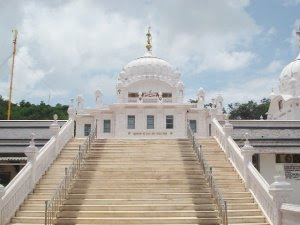
hello everyone this a perfect place to get your knowledge updated about Sikhism.what it is,how it is and why it is?
Sikh is the title and name given to an adherent of Sikhism.The term has its origin in the Sanskrit sisya "disciple, learner" or śikṣa "instruction".
According to Article I of "Sikh rehat maryada" (the Sikh code of conduct & conventions) a Sikh is defined as "any human being who faithfully believes in One Immortal Being; ten Gurus, from Guru Nanak Sahib to Guru Gobind Singh Sahib; the Guru Granth Sahib; the utterances and teachings of the ten Gurus and the baptism bequeathed by the tenth Guru; and who does not owe allegiance to any other religion".
It is important to understand that all the symbols that make a fully baptized Sikh's appearance so distinctive are optional to "slow adopter"Sikhs. These individuals believe in the principles of Sikhism and identify as Sikh but have not yet decided they are ready to make the commitment to become baptized. Some Sikhs may never make this decision in their lifetimes.
So while some slow-adopter Sikhs will indeed display some of the most overt signs, such as uncut hair (and consequently turbans for both sexes and beards on men), this is not necessarily the case.
The most common symbol of all Sikhs, because of its simplicity, is a steel bracelet, a physical reminder of devotion.
Guru Nanak,the founder of the faith, summed up the basis of Sikh lifestyle in three requirements:Naam japo,Kirat karo and Wand kay shako, which means meditate on the holy name ( Waheguru), work diligently and honestly and share one's fruits.
The Sikhs revere Guru Granth Sahib as their supreme teacher, as it is a literal transcript of the teachings of the Sikh Gurus. The tenth guru appointed Guru Granth Sahib as his successor. Compiled by the Sikh Gurus, and maintained in its original form, Sikhs revere Guru Granth Sahib as their supreme guide. Non-Sikhs can partake fully in Sikh prayer meetings and social functions. Their daily prayers include the well being of all of mankind.
The concept of saint-soldier is a unique feature of Sikhism. Every Sikh is required to aspire to sainthood by his devotion to God and service to mankind, but also, according to the situation, to adopt the role of the soldier. The Sikhs look at the Martydom of the NINTH GURU for trying to protect Hindus from religious persecution, in Delhi,on 11 November 1675 AD, as an example to be followed.
Sikhs are required not to renounce the world, and aspire to live a modest life. SEWA (service) is an integral part of Sikh worship, very easily observed in the GURUDWARA. Visitors of any religious or socio-economic background are welcomed, where LANGAR (food for all) is always served.
The Sikhs also revere Bhaktas or Saints belonging to different social backgrounds. The work of these BHAGATS is collected in Guru Granth Sahib, and is known as Bhagat-Bani (sacred word of bhagat) as against work of Sikh Gurus being known as Gur-Bani (sacred word of guru).
if u want any information on Sikhism or you have any questions please contact us at:-mail@karsewa.tk
info@karsewa.tk
we will be glad to assist you


